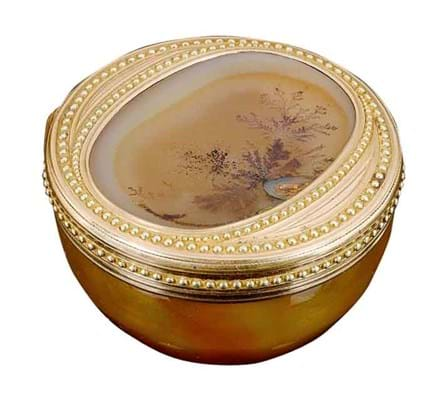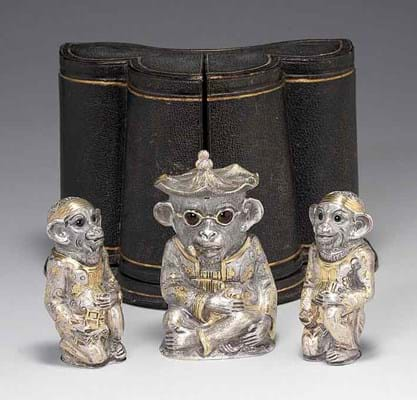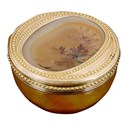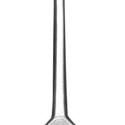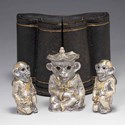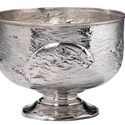Of the 333 lots on offer, 238 sold (72 per cent) for a sum of £1.15m. This was the first time they had broken the £1m mark and was also higher than any silver sale staged under the Phillips name.
Bonhams' silver specialist Rupert Slingsby said that private collectors and the trade came out in force and identified at least one new private collector on the books.
The sale started with a collection of gold boxes and objects of vertu from Drummuir Estate, Keith, Banffshire. It was put together in the early 19th century by John Duff (1772-1836), who was a Scot by birth but much preferred the attractions of the Continent. When he died without an heir the collection passed to his brother, who managed the estate, and was subsequently passed down through the generations.
Drummuir is still in private hands, but the boxes were never really liked or displayed, so when vertu specialist Michael Moorcroft was invited to look at them, he found an almost entirely intact suitcase full of boxes in exceptional condition, many still in their original leather and shagreen carrying cases.
Normally, this sort of thing would have been catalogued or published, but having never been seen before, they attracted strong interest from the London trade, European privates and some Russian collectors. All but two of the 27 sold, contributing £220,080 to the total.
"The prices we saw were what you would have expected as retail five or ten years ago," said Mr Moorcroft. "There are a few people that dominate buying, because you still have to pay stratospheric prices in this market, but the buying base is certainly larger now than it was a decade ago. There is a lot more competition."
The most sought-after was a Louis XVI circular gold example, inset on the top with a panel of forest agate in brown, mustard and cream, with bead borders. Made in 1781-3, it was signed Roucel orfe du Roy A Paris for the prolific maker Louis Roucel.
It had later recense marks for 1809 and 1819 and Mr Moorcroft said the base, made of solid agate in a bowl shape, was very unusual. It fetched £38,000 from a European collector.
The same collector purchased a 3in (7.6cm) long rectangular French First Republic example by Adrien-Jean- Maximilien Vachette, Paris 1789, with Vachette's pre-Revolutionary maker's mark. It was also mounted with a forest agate panel with a fluted and guilloche frame and it fetched £34,000.
In some cases the condition was so immaculate the boxes looked new, like the 3in (7.3cm) long French First Republic Palais Royal gold-mounted mother-of-pearl example, intricately decorated with gold and shell floral panels, from Paris 1798-1809. This helped it to a strong double-estimate bid of £10,000 despite the unknown maker.
Spoon collection
The auction also included a 23-lot selection of spoons comprising the second tranche of the Quernmore Collection, the first part of which was offered at a different auctioneer years ago. Largely put together in the late 1990s, 19 of the items found buyers.
The highlight was a Henry VIII silver apostle spoon that the vendor had purchased from David Lay of Penzance in November 1995 for £17,000. The 7in (18cm) long spoon dates from 1515 and has a nimbus formed as a Tudor rose and a gilded finial modelled as St Matthias with an axe in his right hand.
It was probably one from a set of 12 or 13 - another of the same date has been recorded, with an identical nimbus and figure, but instead holding a Fuller's bat, the emblem of St James the Less, but its present whereabouts are unknown.
This example was guided at £20,000-25,000 but its early date and rarity prompted a member of the London trade to bid a winning £28,000 on the phone.
Silver animals
Another collection comprised 20 lots of novelty silver animals, most of which were bought from Garrard's in the 1980s, which proved predictably popular and sold out bar two lots. "It was such a nice collection, and one like it hasn't come up for a long time. We had a lot of private interest, and overall it was estimated at £90,000 but ended up making £170,000," said Mr Slingsby.
The star was a George IV silver gilt 41/2in (11.5cm) high mustard pot and spoon by John Bridge, London 1824, stamped Rundell Bridge Et Rundell Aurifices Regis Londini. It was modelled as a monkey standing over a barrel and laughing. Bonhams had estimated it at £6000-8000 but it was knocked down at £22,000 to the trade.
As usual, primates dominated. Another popular lot was a three-piece Victorian silver and silver-gilt condiment set, the 4in (10cm) high mustard pot modelled as a monkey sitting cross-legged with a pipe in his mouth, offered together with two smaller pepper pots of smaller monkeys holding snuffboxes. They all had glass eyes and were wearing oriental dress with different hats, and came in their original case. Again they were competed past estimate to £21,000.
Punch bowl
The highpoint of the sale was not from one of the private collections but had been entered by a private individual. It was an 8in (21cm) high, 67oz Arts and Crafts silver punch bowl chased with salmon, made by Gilbert Marks, London, 1897. It was made for presentation, hence the engraving on the interior: Solent, One design Class Special Prize, Presented by Commodore H R H The Prince of Wales, Cowes, August 5th 1898, won by Captain J D Barry's "Tangerine".
Aside from its usability and attractiveness, Mr Slingsby said work by Marks is rare, and it quadrupled expectations when it sold to an anonymous buyer at £43,000.
The buyer's premium was 20/12%.

